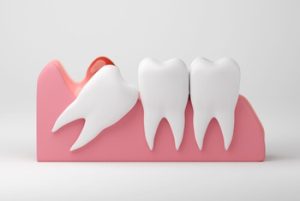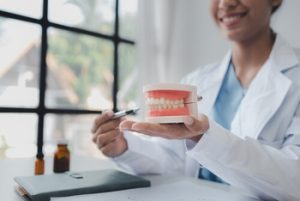Wisdom tooth pain is a common dental concern that affects many young adults and even older patients. But what’s puzzling for most people is how the pain doesn’t always stick around. One day, everything feels fine. Next, you’re wincing in discomfort from a painful wisdom tooth. So, why does wisdom tooth pain come and go?
In this guide, we’ll explore the possible reasons behind this frustrating pattern, what it means for your oral health, and when to consider wisdom tooth removal. Whether it’s your first time dealing with wisdom teeth pain or you’ve been facing recurring flare-ups, identifying the underlying cause is key to finding lasting relief.
Meet the Culprit: What Are Wisdom Teeth?
Wisdom teeth, also called third molars, are the last adult teeth to come through. Most people have four, one in each corner of the mouth, and they usually erupt between the ages of 17 and 25. For some, these new wisdom teeth settle in with no issue. However, many others cause pain, swelling, or even infection due to their limited space in the human jaws.
Why Does Wisdom Tooth Pain Come and Go?

Wisdom teeth, also known as third molars, are the last to erupt, usually during your late teens or early twenties. Since the human jaw has evolved to be smaller over time, there often isn’t enough room to accommodate these four wisdom teeth. This lack of space can cause the wisdom teeth to grow at odd angles or become trapped beneath the gum surface, leading to what’s known as an impacted wisdom tooth.
Now, here’s the tricky part: pain from impacted wisdom teeth doesn’t always remain constant. It may surface suddenly, fade over time, and return later with even greater intensity. This stop-start cycle of wisdom tooth discomfort can happen due to several reasons:
1. Shifting Position as Wisdom Teeth Emerge
Wisdom teeth don’t usually come through all at once. They may push against gum tissue or other teeth gradually, creating pressure that results in sore or swollen gums. As the tooth moves slightly or pauses in growth, the pain may ease. But when growth resumes, so does the discomfort. This is especially true for partially erupted wisdom teeth, where only part of the tooth breaks through the gum while the rest remains trapped.
2. Temporary Gum Inflammation
As the wisdom teeth break through, the gum tissue around them may become inflamed. This inflammation can cause periods of tenderness or throbbing pain, especially when chewing. If the area is irritated by food, plaque, or bacteria, it might swell and become painful. Once the inflammation dies down, either on its own or due to improved oral hygiene, the pain may subside temporarily.
3. Food Trapped Around the Tooth
A partially erupted tooth creates a flap in the gum where food and debris can collect. This pocket is difficult to clean and can quickly become a breeding ground for bacteria. The result is irritation, infection, or even the beginnings of gum disease. You may feel pain when the pocket is active or inflamed, and relief may be felt once the area settles down with care, rinsing, or antibiotics.
4. Pressure on Adjacent Teeth
Wisdom teeth often grow sideways or at an angle due to a lack of space. As they press against adjacent teeth, they can cause dental pain, jaw tightness, and headaches. When the pressure eases slightly, such as from the tooth shifting or you adjusting your chewing habits, the pain may diminish. But it’s likely to return as the wisdom tooth continues to push forward.
5. Infection and Immune Response
If bacteria reach the gum around a wisdom tooth, it can trigger an infection called pericoronitis. This condition leads to painful swelling, bad breath, difficulty opening the mouth, and even fever. Sometimes, your immune system fights off the infection, easing the pain. But unless the underlying cause is treated, the pain will likely return during another flare-up.
6. External Factors That Exacerbate Pain
Stress, illness, poor sleep, and even hormonal changes can make you more sensitive to pain. Clenching your jaw or grinding your teeth, specifically at night, can also worsen wisdom tooth discomfort. This can lead to intermittent pain that seems to appear and disappear without a clear cause.
7. Sinus Pressure and Upper Jaw Pain
The upper wisdom teeth sit near the sinus cavities, which can sometimes lead to overlapping symptoms or discomfort in both areas. When these sinuses become inflamed, it can mimic wisdom tooth pain or aggravate existing discomfort. If the sinus pressure subsides due to treatment or changes in weather, the pain may ease, only to return during the next sinus flare-up.
8. Counter Pain Relief Masking Symptoms
Pain relievers like ibuprofen or paracetamol can effectively alleviate pain and reduce inflammation. However, they may also mask the underlying issue. You might feel better for a while, giving the illusion that the problem has resolved, when in fact, the wisdom tooth is still causing trouble below the surface.
How Wisdom Teeth Affect Oral Health
Your wisdom teeth may seem like just an extra set of molars, but they can significantly impact your overall oral health. Here’s how:
- They can cause tooth decay: Partially erupted wisdom teeth are hard to clean, increasing the risk of decay.
- They can lead to gum disease: Inflammation around the area can spread to nearby gum tissue, threatening gum health.
- They can damage other teeth: Wisdom teeth pushing on adjacent teeth can cause alignment issues and pain.
- They may cause bad breath: Trapped food and bacteria in hard-to-reach areas can lead to unpleasant odours.
If not addressed early, a painful wisdom tooth can eventually lead to more severe complications that affect the health of other adult teeth.
Signs It’s Time to See a Dentist
Pain is your body’s way of saying something’s not right. If you notice the following symptoms along with recurring wisdom teeth pain, consult a dentist for a thorough examination:
- Swollen gums near the back of your mouth
- Persistent pain or throbbing in your jaw
- Pain that radiates to your ear or neck
- Difficulty chewing or opening your mouth fully
- Redness, pus, or bleeding in the affected area
- Fever or signs of infection
A proper diagnosis is crucial to determine whether you need wisdom tooth extraction or another treatment to relieve dental pain.
The Role of Impacted Teeth in Dental Pain
Impacted wisdom teeth are one of the leading causes of intermittent pain. Here’s what typically happens:
- No room to grow: Human jaws often don’t have enough space for extra molars, causing the teeth to become trapped.
- Wrong angle: When a wisdom tooth grows sideways or at an angle, it can irritate the gum or press against other teeth.
- Pressure and inflammation: This contributes to gum pain, toothache, or even headaches in some cases.
Impacted teeth won’t correct themselves. Pain may ease for a while, but the tooth will likely continue causing problems unless addressed.
Managing Wisdom Tooth Pain at Home
Until you can see your dentist, there are a few safe ways to manage wisdom tooth discomfort at home:
1. Saltwater Rinse
Rinsing with warm saltwater can help soothe swollen gums and keep the affected area clean. Be sure to swish gently to avoid irritating sensitive tissue.
2. Ice Pack
Placing a cold compress on the cheek near the sore jaw can reduce inflammation and numb the area temporarily.
3. Over-the-Counter Pain Relief
Counter-pain medications like ibuprofen or paracetamol can help alleviate pain and discomfort. Always follow the label instructions.
4. Maintain Good Oral Hygiene
Brush and floss carefully, especially near the affected area, to remove food debris and reduce bacterial build-up.
5. Avoid Hard or Crunchy Foods
Stick to soft foods that won’t irritate swollen gums or partially erupted teeth.
These remedies may offer short-term relief, but they won’t resolve underlying issues like impacted wisdom teeth or infection.
When Wisdom Tooth Removal Becomes Necessary
Wisdom tooth extraction is frequently the most suitable option in cases where:
- Pain becomes frequent or severe
- Your wisdom teeth are impacted
- There’s a risk of damaging other teeth
- Gum infections keep returning
- You’re planning orthodontic treatment and need more space
Removing the painful wisdom tooth can help prevent future complications, protect surrounding teeth, and support long-term oral health.
What to Expect During Wisdom Tooth Extraction
The process of having wisdom teeth removed depends on whether the tooth has erupted or is still under the gum. Here’s a quick overview:
- Initial consultation: Your dentist will use X-rays to assess the position and alignment of your third molars.
- Anaesthetic: A local anaesthetic is used to numb the area.
- Extraction: The tooth is carefully removed. If it’s impacted, a small incision in the gum may be needed.
- Recovery: Soreness and swelling are common after the procedure, but they can be managed with adequate rest, cold compresses, and over-the-counter pain relief.
It’s normal to have some dental pain for a few days after surgery, but the long-term relief is usually worth it.
How to Prevent Future Wisdom Tooth Pain
Although you can’t prevent wisdom teeth from developing, there are steps you can take to reduce the chances of painful flare-ups:
- Keep up with regular dental checkups
- Practise good oral hygiene daily
- Use an antibacterial mouthwash if advised by your dentist
- Avoid smoking, which can slow gum healing
- Report any new symptoms early
Maintaining a regular oral hygiene routine and monitoring any new wisdom tooth discomfort can help you catch and manage issues early before they become more serious.
FAQs About Wisdom Tooth Pain
- Why does wisdom tooth pain come and go instead of staying constant?
Wisdom tooth pain often fluctuates due to factors like partial eruption, infection, or pressure on surrounding teeth. As these conditions change, so does the intensity of the pain.
- How do I know if my wisdom tooth is impacted?
Signs of an impacted wisdom tooth include persistent pain, swelling, jaw stiffness, bad breath, and difficulty opening your mouth. A dentist can confirm this with an X-ray.
- Can I treat wisdom tooth pain at home?
Yes, short-term relief is possible with saltwater rinses, ice packs, over-the-counter pain relievers, and soft foods. However, ongoing or severe pain should be assessed by a dentist.
- Can wisdom tooth pain go away on its own?
In some cases, mild pain may subside temporarily, especially if caused by minor irritation or inflammation. However, if the underlying issue remains, such as impaction or infection, the pain is likely to return.
- How long does it take to recover after wisdom tooth removal?
Most people recover within 3 to 7 days. Swelling and discomfort typically improve within the first few days, especially with rest, good oral hygiene, and pain relief methods.
Final Thoughts: Don’t Ignore That On-and-Off Pain

Managing wisdom tooth pain at home may offer temporary relief, but if the discomfort keeps returning, it’s time to seek professional advice. Delaying treatment can cause severe pain, infection, or damage to adjacent teeth.
To ensure proper care and peace of mind, schedule a dental appointment today at (08) 7078 8263 if your wisdom teeth are causing pain or discomfort. Early treatment and professional dental support can help safeguard your smile and avoid further issues down the track.
Note: Any surgical or invasive procedure carries risks. Before proceeding, you should seek a second opinion from an appropriately qualified health practitioner.
References
Mayo Clinic. (n.d.). Wisdom teeth: Symptoms and causes. https://www.mayoclinic.org/diseases-conditions/wisdom-teeth/symptoms-causes/syc-20373808
GoodRx. (n.d.). Popular over-the-counter pain relievers. https://www.goodrx.com/conditions/pain/popular-over-the-counter-pain-relievers
NHS. (n.d.). Gum disease. https://www.nhs.uk/conditions/gum-disease/
Cleveland Clinic. (n.d.). Bad breath (halitosis). https://my.clevelandclinic.org/health/diseases/17771-bad-breath-halitosis
Colgate. (n.d.). What is good oral hygiene? https://www.colgate.com/en-us/oral-health/adult-oral-care/what-is-good-oral-hygiene


